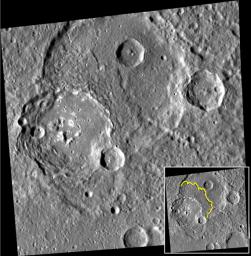Going with the Flow
Caption:
The left side of today's image is dominated by an unnamed 75-km-diameter impact crater. The crater has several interesting features. Its western wall is quite broad, with extensive terracing and landslide scarps. The floor of the crater is flat, having been filled by volcanic plains or impact melt. The small central peaks, parts of the floor, and spots along the eastern rim are dotted with high-reflectance
hollows
. Finally, as outlined in the inset, the ejecta to the north and east of the rim appears to have flowed along the ground, and formed a terminal scarp. A recent paper by Beary Xiao and Goro Komatsu discusses this and other mercurian craters that have flow-like ejecta, and makes comparisons with similar landforms on the Moon and Mars.
Z. Xiao and G. Komatsu (2013), Impact craters with ejecta flows and central pits on Mercury,
Planetary and Space Science
, vol. 82-83, pp. 62-78.
This image was acquired as part of MDIS's high-resolution stereo imaging campaign. Images from the stereo imaging campaign are used in combination with the surface morphology base map or the albedo base map to create high-resolution stereo views of Mercury's surface, with an average resolution of 200 meters/pixel. Viewing the surface under the same Sun illumination conditions but from two or more viewing angles enables information about the small-scale topography of Mercury's surface to be obtained.
Date acquired:
November 03, 2011
Image Mission Elapsed Time (MET):
228803487
Image ID:
966206
Instrument:
Wide Angle Camera (WAC) of the Mercury Dual Imaging System (MDIS)
WAC filter:
7 (748 nanometers)
Center Latitude:
13.45°
Center Longitude:
298.0° E
Resolution:
182 meters/pixel
Scale:
The scene is about 190 km (118 mi.) across
Incidence Angle:
68.6°
Emission Angle:
15.5°
Phase Angle:
55.3°
North is up in this image.
Background Info:
The MESSENGER spacecraft is the first ever to orbit the planet Mercury, and the spacecraft's
seven scientific instruments and radio science investigation
are unraveling the history and evolution of the Solar System's innermost planet. MESSENGER acquired over 150,000 images and extensive other data sets. MESSENGER is capable of continuing orbital operations until early 2015.
For information regarding the use of images, see the MESSENGER
image use policy
.
Cataloging Keywords:
| Name |
Value |
Additional Values |
| Target |
Mercury |
Mars |
| System |
|
|
| Target Type |
Planet |
|
| Mission |
MESSENGER |
|
| Instrument Host |
MESSENGER |
|
| Host Type |
Orbiter |
|
| Instrument |
Mercury Dual Imaging System (MDIS) |
|
| Detector |
Wide Angle Camera (WAC) |
|
| Extra Keywords |
Color, Crater, Impact, Map, Moon, Radio, Volcano |
| Acquisition Date |
|
| Release Date |
2014-01-06 |
| Date in Caption |
2011-11-03 |
|
| Image Credit |
NASA/Johns Hopkins University Applied Physics Laboratory/Carnegie Institution of Washington |
| Source |
photojournal.jpl.nasa.gov/catalog/PIA17850 |
| Identifier |
PIA17850 |

 Planetary Data System
Planetary Data System
